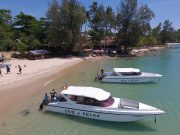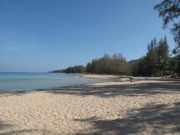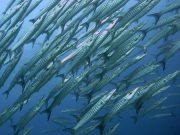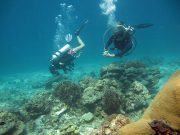Lanta Weather & Climate
When planning your trip, it's important to know when is the best time to visit Koh Lanta, and what to expect from the weather and sea conditions.
The tropical island of Koh Lanta is located close to the mainland Krabi province in southern Thailand, close to Malaysia and Sumatra (Indonesia).


Koh Lanta sits just 7.6 degrees above the equator and it's tropical climate ranges from warm and wet in the summer to cool and dry in the winter.
Find out all about Koh Lanta, and how to get to Koh Lanta from Krabi, Ao Nang, Koh Jum, Phi Phi, Koh Lipe and Phuket.
When is the Best Time to visit Koh Lanta?
The Koh Lanta diving season is generally the high season months from late October to early May. The wind is mostly from the east, blowing through the South China Sea into the Gulf of Thailand.
The Thai-Malay Peninsula acts as a wind buffer and here on Koh Lanta we usually experience extended periods of sunny days with flat calm seas and little or no rain.
Despite the often great high season weather, we can however occasionally have localised afternoon thunderstorms, with winds sometimes being stronger or changing direction for short periods.
During periods of stronger winds, which can occasionally last for a few days, we may need to change our dive trip schedules.
Water Temperature @ Koh Lanta's Dive Sites
The sea water temperature at most dive sites varies from 28 - 31 degrees throughout the year.
Generally the cooler months are November, December and January, with the hottest and most humid months typically being March and April.
Thermoclines can occasionally drift past, bringing a 'chilly' 26 - 27 degrees for a few minutes underwater. Sometimes we can find less common marine life species in bodies of cooler water.
Lanta Low Season Months
During the typical rainy season months of June to end of September, the westerly monsoon winds from the Indian Ocean bring periods of rain and the occasional storms, however Koh Lanta can also experience long periods of sunshine and calm seas throughout the summer months.
The wettest weather is traditionally in June and September.
Unfortunately the monsoon winds that control Koh Lanta's weather do not change direction on time every year. This means that the rainy season can start later in June, with a break for several months of fine weather and then sometimes start again at the beginning of 'high season' to continue well into January.
Koh Lanta Typical Weather Summary
| Month | Typical Weather |
| October: | Windy with some rainfall. Improvement in the middle of the month |
| November: | Nice weather with pleasant temperatures, the end of the S/W Monsoon |
| December: | Sunny weather with calm seas and not much wind |
| January: | Sunny weather with pleasant temperatures and clear water |
| February: | Sunny weather with pleasant but higher temperatures and clear water |
| March: | Sunny weather, higher temperatures, calm water with some plankton |
| April: | Hot weather, calm sea with plankton, it might rain at night |
| May: | Hot weather, calm sea with plankton, it might rain at night |
| June: | Start of the S/W Monsoon. Stronger winds, some rainfall and rougher seas |
| July: | Windy, sunny with some rainfall |
| August: | Windy, sunny with some rainfall |
| September: | Stronger winds, rougher seas with some rainfall |
Koh Lanta Diving Conditions
Diving conditions vary throughout the year, the best conditions typically being October to early May, though of course the weather can be unpredictable at any time.
Occasionally we can have a few days of stormy weather at some point during the high season months.
Diving in low season is possible, with the best conditions likely between early July and late August.


Book online to save 10% on dive trips and scuba courses on Koh Lanta.
Visibility @ Koh Lanta's Dive Sites
Visibility varies throughout the year, ranging from 5 - 10m on Koh Phi Phi after stormy weather to 30m+ at Koh Haa and Koh Bida during periods of fine weather.
Currents can bring plankton at any time of year which reduces visibility and makes the water more greenish and this provides food for larger sea creatures. This is important because (for example) we are more likely to see manta ray at Hin Daeng & Hin Muang with greenish water and slight currents than with blue water and 40m+ visibility. Thermoclines can appear at any time and can also affect visibility.
Koh Lanta Weather Forecast
Please remember that the above is only a rough guide based on our observations over the past years.
We don't pretend to be able to forecast the weather and often the weather forecast is wrong (please do not ask us to predict the weather in advance of your trip to Koh Lanta!).
For those of you looking for more information, there are many weather resources on the internet to help with your planning:


